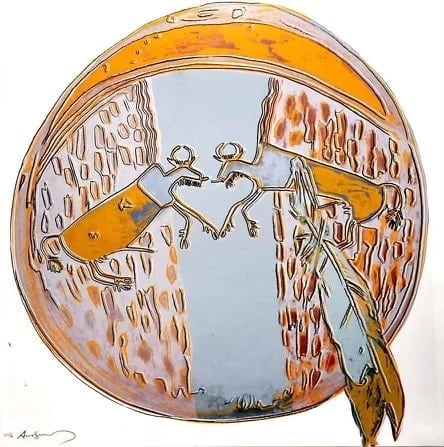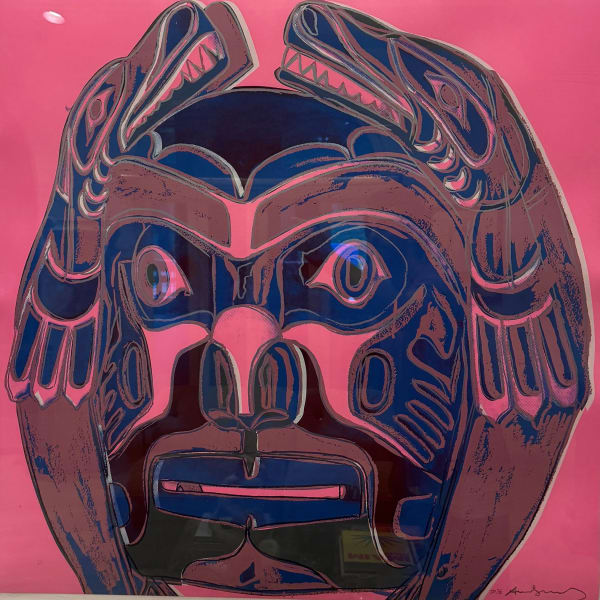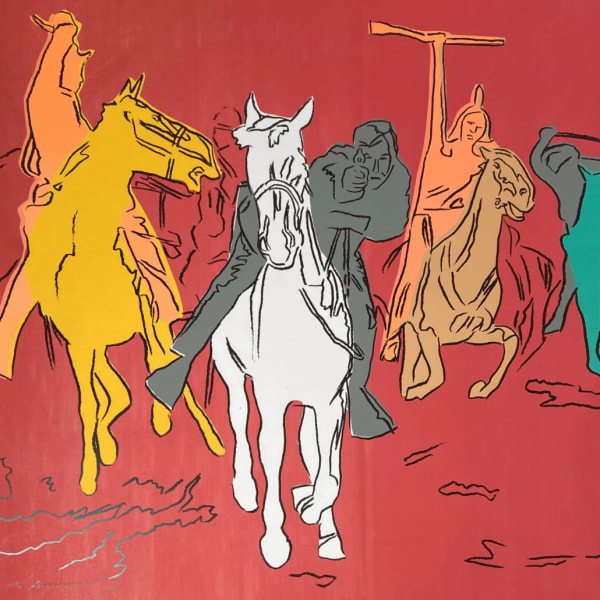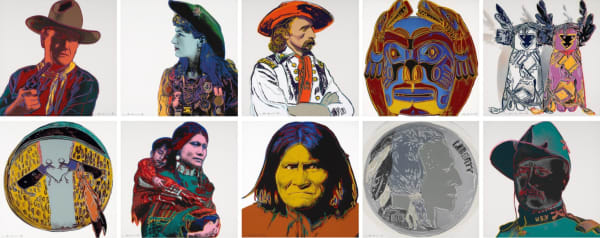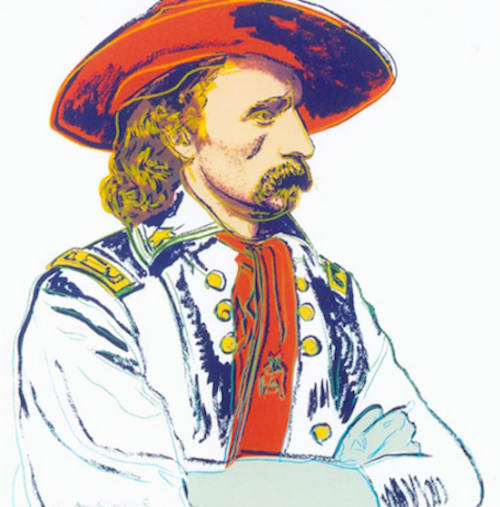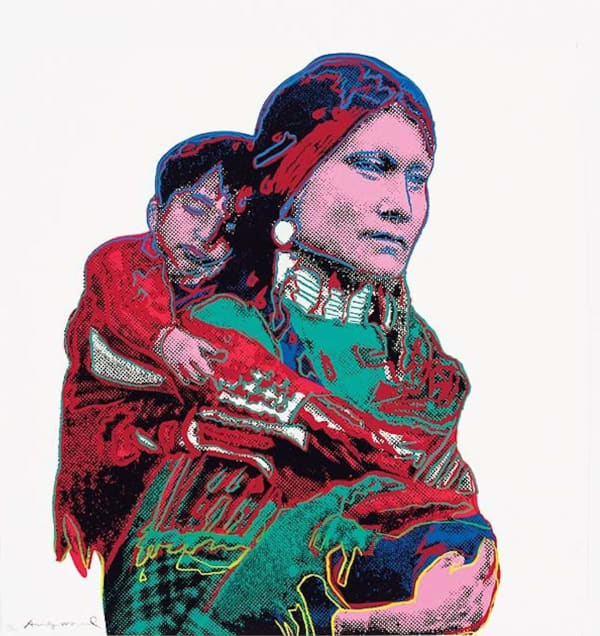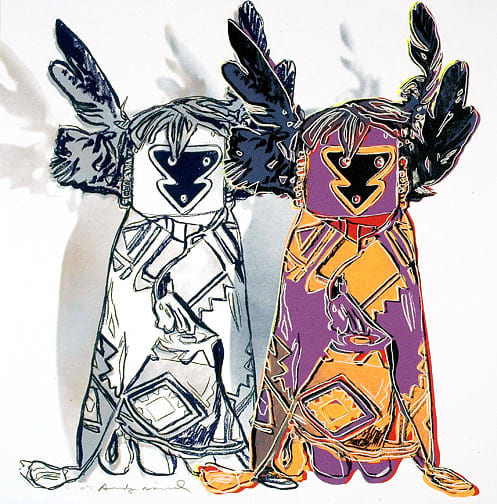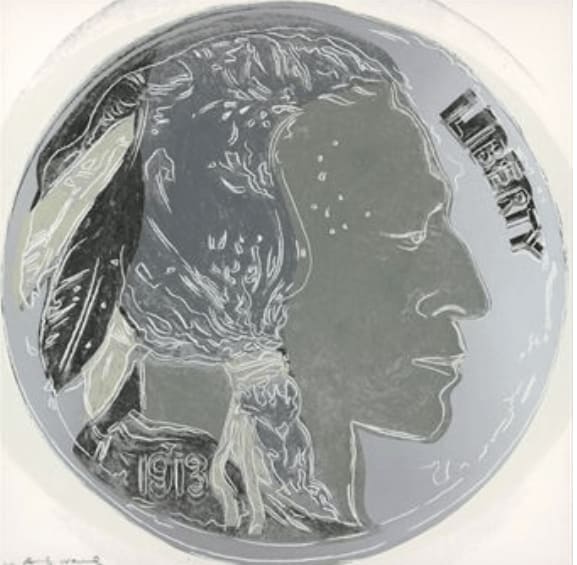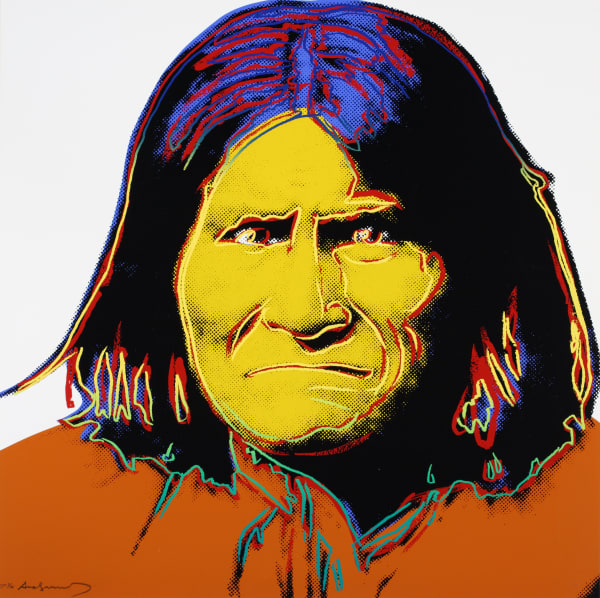
Andy Warhol
91.4 x 91.4 cm
Andy Warhol, the iconic figure of the Pop Art movement, is renowned for his bold and innovative approach to art. Among his extensive body of work, one intriguing piece stands out: his Kachina Dolls print from the Cowboys and Indians series. This series, created in the 1980s, explores Warhol's fascination with American culture, particularly its myths and icons.
In the Kachina Dolls print, Warhol delves into the symbolism and mystique of Native American culture, specifically focusing on the Kachina dolls. These dolls, originating from the Pueblo people of the Southwestern United States, hold significant cultural and religious significance. Traditionally, Kachina dolls are crafted from cottonwood root and represent various spirits or deities in the Pueblo cosmology. They are used in religious ceremonies and as educational tools for teaching tribal history and spiritual beliefs.
Warhol's rendition of Kachina dolls is striking in its simplicity and vibrancy, characteristic of his signature style. He employs his trademark techniques of repetition and vivid colors to capture the essence of these sacred objects. Through his bold use of color and imagery, Warhol transforms the Kachina dolls into modern-day icons, elevating them to the realm of popular culture.
The juxtaposition of the Kachina dolls within the Cowboys and Indians series is particularly intriguing. This series explores the mythology and stereotypes surrounding the American West, including its representation in Hollywood films and popular imagination. By incorporating Kachina dolls alongside images of cowboys and Native American figures, Warhol challenges conventional narratives and invites viewers to reconsider their perceptions of Native American culture.
Moreover, Warhol's appropriation of the Kachina dolls raises questions about cultural appropriation and commodification. While Warhol celebrates the visual appeal of these objects, some critics argue that his use of Native American imagery overlooks the deeper spiritual and cultural significance behind them. Nevertheless, Warhol's Kachina Dolls print serves as a reflection of the complexities inherent in the intersection of art, culture, and identity.
Overall, Andy Warhol's Kachina Dolls print from the Cowboys and Indians series stands as a testament to his artistic innovation and his exploration of American culture. Through his distinctive style and provocative imagery, Warhol invites viewers to contemplate the intersections of tradition and modernity, spirituality and consumerism, and the enduring allure of cultural icons.
-
 Andy WarholPlains Indian Shield F.S. II 382, from Cowboys and Indians , 1986
Andy WarholPlains Indian Shield F.S. II 382, from Cowboys and Indians , 1986 -
 Andy WarholNorthwest Coast Mask F.S. II 380, from Cowboys and Indians , 1986
Andy WarholNorthwest Coast Mask F.S. II 380, from Cowboys and Indians , 1986 -
 Andy WarholAction Picture F.S. II 375, from Cowboys and Indians, 1986
Andy WarholAction Picture F.S. II 375, from Cowboys and Indians, 1986 -
 Andy WarholJohn Wayne F.S. II 377, from Cowboys and Indians, 1986
Andy WarholJohn Wayne F.S. II 377, from Cowboys and Indians, 1986 -
 Andy WarholWar Bonnet Indian F.S. II 373, from Cowboys and Indians, 1986
Andy WarholWar Bonnet Indian F.S. II 373, from Cowboys and Indians, 1986 -
 Andy WarholCowboys and Indians F.S. II 377-386 Cowboys and Indians, 1986
Andy WarholCowboys and Indians F.S. II 377-386 Cowboys and Indians, 1986 -
 Andy WarholAnnie Oakley F.S. II 378, from Cowboys and Indians , 1986
Andy WarholAnnie Oakley F.S. II 378, from Cowboys and Indians , 1986 -
 Andy WarholBuffalo Nickel F.S. II 374, from Cowboys and Indians, 1986
Andy WarholBuffalo Nickel F.S. II 374, from Cowboys and Indians, 1986 -
 Andy WarholGeneral Custer F.S. II 379, from Cowboys and Indians, 1986
Andy WarholGeneral Custer F.S. II 379, from Cowboys and Indians, 1986 -
 Andy WarholAnnie Oakley F.S. II 378, from Cowboys and Indians , 1986
Andy WarholAnnie Oakley F.S. II 378, from Cowboys and Indians , 1986 -
 Andy WarholPlains Indian Shield F.S. II 382, from Cowboys and Indians , 1986
Andy WarholPlains Indian Shield F.S. II 382, from Cowboys and Indians , 1986 -
 Andy WarholNorthwest Coast Mask F.S. II 380, from Cowboys and Indians , 1986
Andy WarholNorthwest Coast Mask F.S. II 380, from Cowboys and Indians , 1986 -
 Andy WarholTeddy Roosevelt F.S. II 386, from Cowboys and Indians , 1986
Andy WarholTeddy Roosevelt F.S. II 386, from Cowboys and Indians , 1986 -
 Andy WarholMother and Child F.S. II 383, from Cowboys and Indians , 1986
Andy WarholMother and Child F.S. II 383, from Cowboys and Indians , 1986 -
 Andy WarholKachina Dolls F.S. II 381, from Cowboys and Indians , 1986
Andy WarholKachina Dolls F.S. II 381, from Cowboys and Indians , 1986 -
 Andy WarholIndian Head Nickel F.S.II 385, from Cowboys and Indians , 1986
Andy WarholIndian Head Nickel F.S.II 385, from Cowboys and Indians , 1986 -
 Andy WarholGeronimo F.S. II 384, from Cowboys and Indians, 1986
Andy WarholGeronimo F.S. II 384, from Cowboys and Indians, 1986
Join our mailing list
* denotes required fields
We will process the personal data you have supplied in accordance with our privacy policy (available on request). You can unsubscribe or change your preferences at any time by clicking the link in our emails.
This website uses cookies
This site uses cookies to help make it more useful to you. Find out more about cookies.
